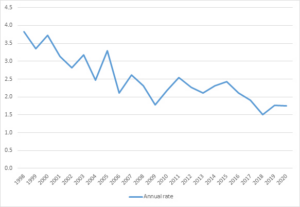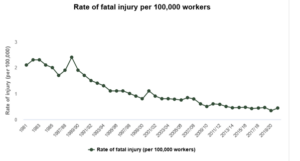In this blog, I will discuss some of the takeaways from the provisional work-related fatality figures released by the Health and Safety Authority for 2021.
The Health and Safety Authority has released provisional annual statistics for last year. These figures show that there has been a significant reduction in the number of workplace fatalities in 2021.
Sadly, a total of 38 people were killed in workplace accidents during 2021 which is the lowest figure since the HSA was established in 1989.
This compares with a total of 54 people killed in 2020 and 48 in 2019.
Rate of fatal work-related incidents per 100,000 workers (Ireland)
I have included the UK statistics below for comparison purposes and these are available from the HSE website https://www.hse.gov.uk/statistics/fatals.htm
While this is excellent news there is still some cause for concern as our fatality rate in Ireland of 1.7 per 100,000 workers in 2020 is more than 3 times that of the UK (0.44 per 100,000 workers.in 2021). Our fatality rate in Ireland by comparison is likely to be around 1.5 per 100,000 for 2021 but this figure has not yet been released by the HSA.
There is clearly more work to be done to prevent work-related fatalities and reduce the human and financial cost of these tragic events. However, from the above graphic, it can clearly be seen that we have almost halved our fatality rate since 1998. This is due in no small way to the efforts of the HSA, government, society in general, employers, trade unions as well as workers.
What are the key takeaways from the fatality data from 2021?
There are a number of key observations from the HSA data:
- The largest number of fatalities were in construction where 10 people were killed in 2021 (down by 38% compared to 2020 when 16 people were killed in construction)
- Nine people were killed in farming (down from 20 fatalities in 2021)
- Six people were killed in Transportation and Storage
- Five people were killed in manufacturing
- Two were killed in forestry and logging
- Two in Water supply, sewerage, waste management, and remediation activities
- Two in Wholesale and retail trade, repair of motor vehicles and personal goods
- One in education
- One in Arts, entertainment, and recreation
What were the main causes of work-related fatalities in 2021?
The main cause of work-related fatalities was:
- Loss of control of a vehicle or its attachments (12 people killed)
- Falls from height (10 people killed)
- Fall, collapse of material from above (4 people killed)
- Loss of control of an animal (3 people killed)
Loss of control of a vehicle and falls from height between them amounted to 58% of the work-related fatalities during 2021. These two causes are areas that employers should be mindful of and are obviously an area for concern.
What is the age profile of those who died in work-related accidents and where did these occur?
Older workers made up the bulk of the work-related fatalities in 2021.
- Nine people died in the 55 to 64 age group
- Eight people killed were 65 years of age and over.
- There were 5 people killed in the 45 to 54 age group
This means that about 45% of people killed in work-related accidents were over 55 years of age and over. In fact, 58% of the workers killed were aged 45 or over.
Two children aged 16 years of age were killed in work-related accidents last year.
Cork, Dublin and Wexford recorded the highest level of fatalities with 5 in each county.
No fatalities were recorded in 2021 in counties Kilkenny, Leitrim, Longford, Louth, Monaghan, Roscommon, Waterford, and Westmeath.
What are the factors that contributed to the reduction in fatalities?
This is not a simple question to answer as there are several factors that may have contributed to the reduction in fatalities for example:
- The role of enforcement by the HSA
- Health and Safety has become increasingly regulated (The SHWWA 2005 and related regulations).
- The increase in employment and the changing nature of employment
- Societal, worker and organisational and stakeholder expectations for good standards of OHS
- Top management commitment and resources
- Increased guidance on risk assessments and safety management
- The role of ISO 45001 and OHS management system certification
- Economic and financial incentive of higher safety standards
- Influence of insurance companies and personal injury claims
- Fear of reputational damage
- Availability of suitably qualified safety professionals
The above list is non-exhaustive and not in any particular order.










